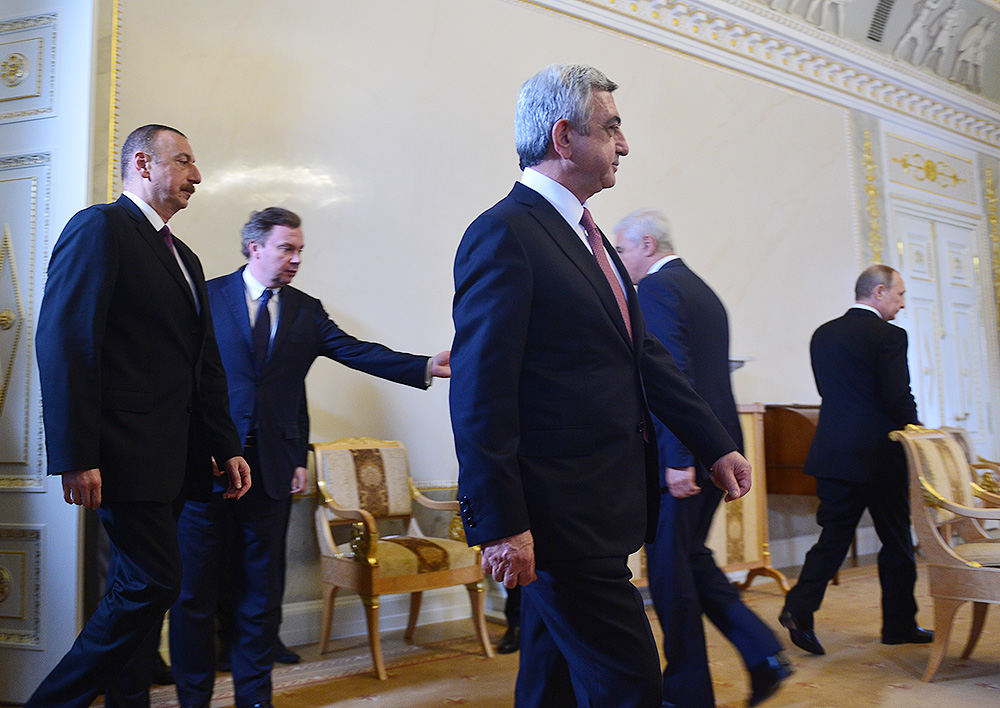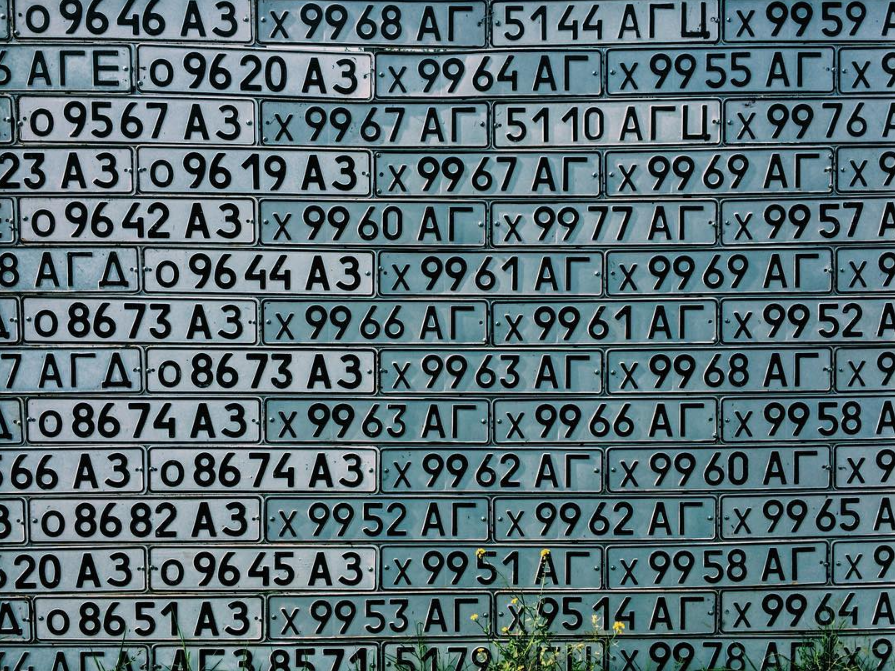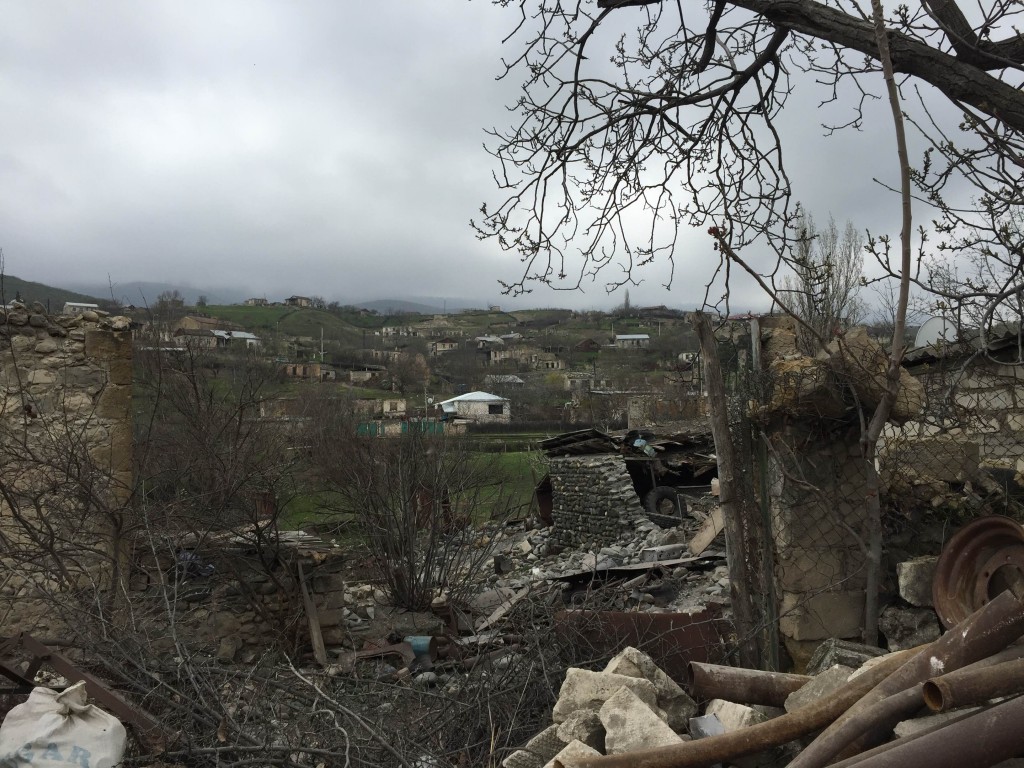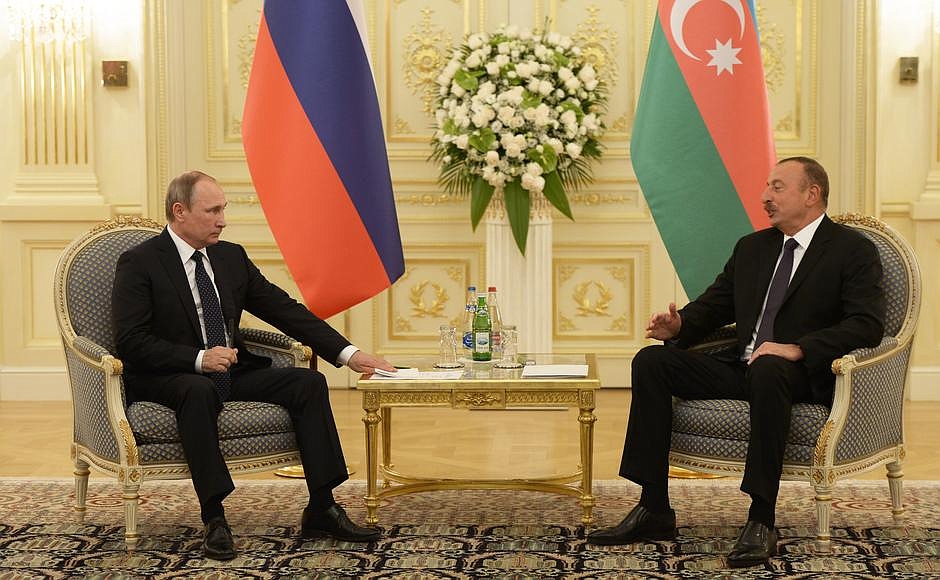Mensoian: Aliyev’s ‘Catch-22’ Dilemma
January 9, 2017Special for the Armenian Weekly
On the one hand, Armenians both inside and outside Artsakh (Nagorno-Karabagh) have been hard at work rebuilding and strengthening the country. Its soldiers—some of whom have made the supreme sacrifice—protect the fledgling state against continuing Azerbaijani aggression, and its citizens—living under wartime conditions—exhibit an enthusiasm and an optimism supported by their belief that one day Artsakh will be completely free.
On the other hand, there is a disturbing counter-move that undercuts these efforts, that is best defined by nuanced statements emanating from Moscow and Yerevan, as well as from the Institute of the Commonwealth of Independent States (CIS).
During his visit to Baku on Aug. 8, 2016, Russian President Vladimir Putin said that he favored a solution to the Nagorno-Karabagh conflict, in which there would be no loser and no winner; in which both sides would benefit. Recently Armenian President Serge Sarkisian echoed the same thought. The Director of the Institute of the CIS is reported to have said that it is not likely that any situation could arise that would place Nagorno-Karabagh under Azerbaijani rule. Given these statements, it would seem that the liberated territories, critical to Artsakh’s security, have already been conceded to Azerbaijan. Any proposed solution that has no “winners or losers” would create a Catch 22 dilemma for Azerbaijani President Ilham Aliyev that could very well save Artsakh its liberated territories… at least for the short term. How unbelievable is that to contemplate?
The ceasefire brokered by Russia in 1994 created the de facto state of the Nagorno-Karabagh Republic. The districts comprising Nagorno-Karabagh together with the liberated territories (especially Shahumyan and Kashatagh) have been effectively integrated and democratically administered by NKR capital Stepanakert since the ceasefire. These are legitimate entry level requirements for de jure recognition.
During the more than two decades that the NKR has existed, Azerbaijan has maintained a belligerent policy toward it and Armenia. During this period, Azeri violations along the Line of Contact (LoC) have been constant, increasing in both number and intensity. Baku has conducted what can be properly described as a war of attrition against Artsakh (and Armenia), which culminated in the Four-Day War launched on April 2, 2016. The Minsk Group countries (France, the United States, and Russia) have essentially condoned these egregious violations by Azerbaijan by failing to rein-in or censor Azerbaijan’s blatant disregard of the ceasefire provisions and any agreement arrived at during the negotiation process.
Just recently President Sarkisian finally (unless I missed prior comments he may have made on this issue) refuted Azerbaijan’s claim that Armenia invaded Azerbaijan. However, it was a weak refutation that would have been more effectively enunciated in a major policy address on the Karabagh issue.
Armenia’s decision to aid the Artsakh Armenians against a developing genocide was both a humanitarian response as well as a moral decision to invoke the Requirement to Protect (R2P) principle. The latter is an evolving concept that requires the government to protect its minorities from harm. However, when that harm is initiated by the government itself, who is there to defend the victims?
This was the situation that unfolded against the Armenian minority in Azerbaijan. For Azerbaijan to claim Armenia invaded its territory is a deliberate misrepresentation of fact to support its claim of territorial integrity. Our inability to effectively counter this erroneous charge has made it the centerpiece of the pre-conditions that are expected to be met. Territorial integrity can only be invoked against a state invading a neighboring state for territorial gain. By allowing Azerbaijan to address the problem as, technically, an irredentist issue, removes from consideration the alienable right of self-determination by the Artsakh Armenians.
Unfortunately, our president continued to say that “there is a solution, and we realize that it should be based on compromise. It is not the case when Armenia, Azerbaijan, or Karabagh would win.” This statement is eerily similar to President Putin’s statement during his visit to Baku, that the solution to the Karabagh conflict should have no winners or losers. It reinforces a previous statement made by President Sarkisian some months earlier, during a meeting in response to the July 2016 take-over of a district police station in Yerevan. To allay the concerns of the Artsakh Armenians that unilateral concessions might be made, he took the opportunity to say, “I repeat once again. There will be no unilateral concessions in the resolution of the Nagorno-Karabagh issue. Never. Nagorno-Karabagh will never be part of Azerbaijan.”
Since Nagorno-Karabagh does not include the liberated territories, President Sarkisian’s statement is worthy of analysis, since it is related to President Putin’s suggested solution. If the solution is where there are no winners (Sarkisian) and no losers (Putin), it implies that Artsakh (along with Armenia) and Azerbaijan must lose some of what each believes is rightly theirs. For the Armenians, it means that Nagorno-Karabagh (not Artsakh) is once again reestablished as an exclave (having an Armenian majority at least for the short term) with a degree of local autonomy. Azerbaijan then regains control of all of the liberated territories. Based on this compromise solution northern Shahumyan, from which the Armenians had been forcibly removed, would remain with Azerbaijan and the Azeri occupied border regions of Martakert and Martuni would, hopefully, be restored to Nagorno-Karabagh.
This is a compromise that both the European Union and the United States would eagerly accept, assuming that cooperating with Russia would be an acceptable price for them to pay to resolve the Karabagh issue. However, it is a solution that fails to accept the basic issue which is a people’s right of self-determination.
Azerbaijan and its ally Turkey are implacable enemies of Armenia. It is a situation that is not going to change anytime soon. The security of Nagorno-Karabagh and Armenia depends on a common border based on its continued control of Kashatagh and Shahumyan. Once a peace treaty reaffirming a Karabagh (not Artsakh) with limited autonomy under Azerbaijani jurisdiction is accepted, what was an on-going crisis will lose its critical status with those countries (except Turkey) that were previously concerned. It will also allow Azerbaijan, with the passage of time, to ignore any requirements set forth in the treaty that would protect the Karabagh Armenians. Turkey’s blatant failure to honor the provisions set forth in the Treaty of Lausanne can be cited as a prime example.
The loss of the liberated territories is assured if the solution envisioned by Putin or Sarkisian is implemented. Note that President Sarkisian has said that all of the occupied territories (the seven Azeri districts currently occupied) could be returned to Azerbaijan with two caveats: that a referendum be held to determine the legal status of Nagorno-Karabagh and that there must be a land connection with Nagorno-Karabagh under Armenian control.
With respect to the first stipulation, why should a referendum be necessary to determine the legal status of Nagorno-Karabagh? That has already been determined by the majority Armenians with their near unanimous vote for independence. It is that vote, based on the principle of self-determination, that the Minsk Group countries have to honor.
With respect to a land connection, only two options are available. Either the Vardenis to Martakert road in the north or the Lachin Corridor road further south. However, whichever road is chosen, Azerbaijan will be granted the right of access to either or both of these east to west oriented corridors without exception since they would pose a barrier to north-south traffic within Azerbaijan. Under no circumstance could these corridors be protected by Armenia (if necessary) or free from traffic harassing tactics by Baku.
The same capricious actions by Baku, treaties notwithstanding, could interrupt our use of Azeri airspace to disrupt or reduce the use and value of Stepanakert International Airport. This, and the limitations associated with a tenuous land corridor, would pose significant obstacles that would hinder the spatial, economic, and military integration of Armenia and Nagorno-Karabagh. During the negotiations, Azerbaijan would likely demand a comparable dedicated land corridor (not simply the right to transit which they formally had) through Syunik connecting it with its Nakhichevan exclave.
Tremendous sacrifices were made by our soldiers—modern-day fedeyes (freedom fighters)—and civilians, in gaining independence and liberating our historic lands. However, the type of compromise solution envisioned by Presidents Putin and Sarkisian can only be accepted as a defeat. To say that there are no winners or that there are no losers, strains credulity.
It is obvious that there is no agreement between Yerevan and Stepanakert on the critical importance of the liberated territories. President Sarkisian seems willing to release all seven of the Azeri territories occupied by Armenian forces. NKR President Bako Sahakyan realizes that these same liberated (occupied) territories are not only vital to his country’s existence, but to Armenia’s future viability.
Here is where President Aliyev’s Catch 22 dilemma could save the day for Artsakh—at least for the short term.
For all of two decades, President Aliyev has assured his people (and himself)—almost daily—that his vaunted military machine could retake Artsakh by force if necessary. His people are well aware of the billions of dollars he has squandered to expand the country’s military establishment. And yet, given his strident rhetoric and the billions of dollars spent, he has failed to make good on his threat to retake Artsakh.
How could he now accept any solution that establishes an enclave connected by a narrow land corridor with Armenia in exchange for the occupied (liberated) territories? Given his repeated claims, he expects Azerbaijan to be made whole again. Not only would he lose face, but it is highly unlikely that his people and the military establishment would allow him to accept such a solution. President Aliyev must realize that such a move could easily provoke a military take-over.

Armenian President Serge Sarkisian, Azerbaijani President Ilham Aliyev, and Russian President Vladimir Putin before a trilateral meeting (Photo: President.am)
We should view it as a victory if President Aliyev’s Catch 22 dilemma prevents him from accepting such a solution. There should be no doubt that he is convinced that he will ultimately prevail. This assumes that the political dynamics in Azerbaijan do not change.
Short of Artsakh receiving de jure recognition, the status quo is our best alternative. It provides us valuable time to expand the critical support Stepanakert needs to continue its economic development; upgrade its social and economic infrastructure; strengthen its military fortifications; and hopefully accelerate the resettlement of people—especially in the Shahumyan and Kashatagh regions.
A stronger Artsakh will be better positioned to confront the future as well as existing boundaries have time to harden and influence perception.
Source: Armenian Weekly
Link: Mensoian: Aliyev’s ‘Catch-22’ Dilemma



